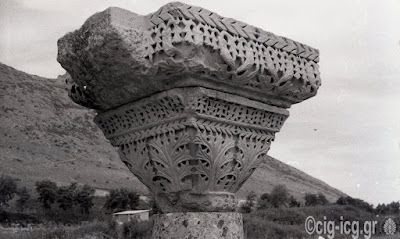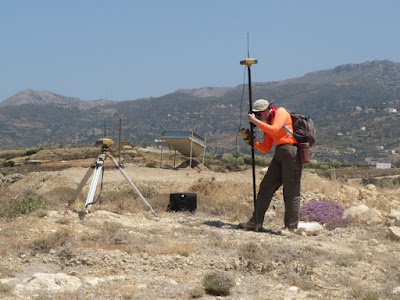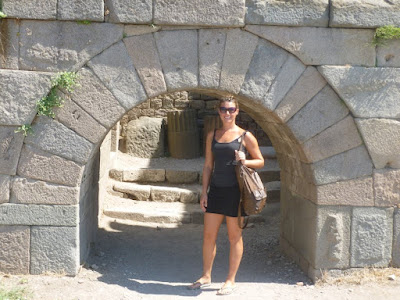It has been an honour to be
the Homer and Dorothy Thompson fellow at the Canadian Institute in Greece
(CIG) for the 2014-15 academic year. My fellowship at CIG allowed me to
engage in full-time dissertation research in some of the best Classical
libraries in the world: the Blegen Library of the American School of
Classical Studies and the British School Library. In my dissertation, “
Mechanisms of Power and Control: the Role of Harbor-City Interaction in the Socio-Political Dynamics of Hellenistic Asia Minor,” I conceptualize harbors as similar socio-economic, political, and religious spaces as
agoras. By examining the spatial relationship between
agoras and
harbors, I elucidate the function of harbors within urban planning and
assert that they were used as a mechanism for negotiating
socio-political relationships between the Macedonian kings and the
residents of Hellenistic cities. I use Miletos, Priene, and Pergamon as
case studies to answer such questions as: how did the maritime
environment reinforce and reflect cultural, political, and religious
ideologies? In what way did the harbor function as a liminal space
mediating communication networks between the
asty,
chora, and
eschatia,
other key sectors of urban life (industrial, religious, and
residential), and the larger Mediterranean world? How did the links
between maritime and terrestrial space facilitate and/or prevent
interaction between Hellenistic kings, and local Anatolian, Greek, and
Macedonian residents, and their claims to power and control?

While in Athens for the last year, I not only moved forward my research,
but also had the opportunity to present my research at international
conferences, such as the EAA in Istanbul, TAG in Manchester, and the
Tombros Conference at Pennsylvania State, as well as my lecture at the
Canadian Institute in Athens. At all of these occasions, I received
invaluable feedback that was driven by current research trends and often
offered by experts in my field of research. Through these conferences,
as well as discussions and lectures within the Athenian academic
community, I am confident that I have grown as an academic and broadened
my approach to my research, which would not have been possible without
this fellowship opportunity.

As part of the CIG team, along with Jonathan, David, and the interns –
Sarah, Tessa, and Christina, I have been able to take an active role in
Canadian archaeological endeavours in Greece. My first involvement with
CIG and Canadian archaeology was as an undergraduate in 2005 through
participation on the Institute’s Kastro Kallithea project in Thessaly, a joint collaboration between the University of Alberta and the 15th
Ephorate in Larissa. I have continued to be part of the Kallithea team
and am proud to participate and support Canadian archaeological
projects. As a M.A. student, I expanded my involvement in Canadian
archaeology in Greece as a Brock University intern at CIG
in 2010. My internship only heightened my interest in the field and my
desire to maintain participation in Greek-Canadian archaeology as I
began a Ph.D. at the University at Buffalo, SUNY in 2011. Consequently,
when the opportunity arose to apply for a fellowship at CIG, I applied
in anticipation of being part of the team once again and promoting
Canadian students and scholars in Greece. Four years later, Jonathan and
David still exhibit the same enthusiasm and desire to maintain and to
advance the Institute’s interests within Greece and back in Canada.

Unlike my three-month internship, however, a nine-month fellowship
offered many more opportunities to become acquainted with the scholars
who pass through the Institute; although I am familiar with much of
their scholarship, I have not had the chance to meet them all. Tristan
Carter’s keynote address about
the Stelida Naxos Archaeological Project
at the Open Meeting really stood out for me, because of his passion,
research questions, and methodology. I believe that it is scholars such
as Prof. Carter who are crucial to ensuring the future of Classical
Studies and Archaeology, by inspiring a new generation of young scholars
to enter the field and pursue dynamic new venues of research.
In addition to networking with Canadian and International scholars, as
the fellow at the Canadian Institute I have broadened my understanding
of past and present Canadian involvement in Greece. During the fall, I
catalogued
the Fred Winter archives
and developed the Portal to the Past, while, in the spring, I focussed
my efforts on consolidating and recording the Institute’s fieldwork
archives. By sifting through these documents, I learned about the
Institute’s work and gained an in depth understanding of the
bureaucratic process of permit applications and archaeological research.
Since its inception, the Canadian Institute has been granted permits
for many fantastic and diverse archaeological projects throughout
Greece, amongst which are
the Persian Wars Shipwreck Survey,
the Mytilene Project,
the Tanagra Survey Project, and
the Kamares Cave Project
on Crete. Although the fieldwork archives were not always easy to wade
through, I truly enjoyed reading the documents and certainly learned a
great deal about Canadian archaeological research in Greece and the
importance of CIG in fulfilling these endeavours.
Although I am sad to say goodbye to the Institute, I will only be
moving across the street to the American School of Classical Studies as
the 2015-16 Jacob Hirsch Fellow, so I will be able to stay in touch. I
am grateful for the opportunity to be part of CIG and will always think
fondly of my time here. Thanks to all of you who made this such a
memorable year for me!
Lana Radloff

























